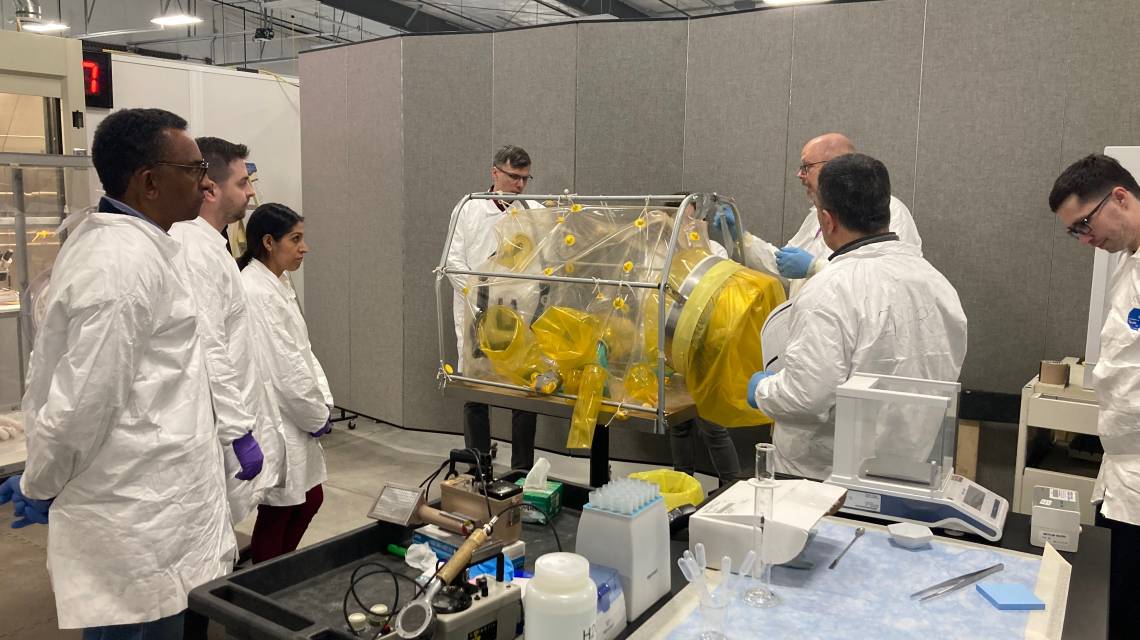At a recent training course organized by the IAEA in the United States, nuclear forensics practitioners from eleven countries learned a range of skills, from how to effectively handle and collect evidence during the early phase of forensics examination, to the careful use of different analysis techniques.
Nuclear forensics is the examination of nuclear or other radioactive material, or of evidence that is contaminated with radionuclides, in the context of legal proceedings under international or national law related to nuclear security. It involves experts that come from a wide variety of scientific disciplines including analytical chemistry, geochemistry and nuclear physics.
"The IAEA systematically assists countries in developing their technical capabilities through activities designed to ensure thorough, hands-on opportunities to exercise the key analytical techniques and approaches of a nuclear forensic examination," said Elena Buglova, Director of the IAEA Division of Nuclear Security.
During the training course at the Pacific Northwest National Laboratory's Volpentest Hazardous Materials Management and Emergency Response (HAMMER) Federal Training Center, 22 nuclear forensics practitioners were granted access to a technical and hands-on learning environment that covered multiple analytical methods.
In one exercise, participants carried out activities which should take place when a sample arrives at a nuclear forensic laboratory. In a typical scenario, a team of experts utilize handheld radiation monitoring equipment to confirm isotope identification measurements taken in the field, as well as ensuring the safety of the team, as they carefully unpack and photograph the samples for documentation.
Participants were also trained on how to perform measurements using gamma spectrometry to determine the presence and abundance of gamma-emitting radionuclides in a sample. After completing gamma spectrometry measurements - which could take several minutes, hours or days, depending on the radioactivity of the sample - the next stage involved deciding whether to further analyse other physical, chemical, elemental and isotopic properties of the sample to further support the investigation. The training course demonstrated how these properties can be measured using a variety of analytical techniques, such as alpha spectrometry, scanning electron microscopy, X-ray diffraction and fluorescence spectrometry and mass spectrometry.

Demonstration of the actions typically taken when a nuclear or radioactive material sample is received and unpacked at a nuclear forensic laboratory. (Photo: G. Eppich/IAEA)
"The course offered us a comprehensive, coherent and sound approach to nuclear or radioactive materials out of regulatory control," said Olivio Pereira de Oliviera Junior, Head of the Nuclear Chemistry Division of the Nuclear and Energy Research Institute (IPEN) in Brazil. "We had the opportunity to enhance our knowledge of forensic and nuclear analytical techniques due to well-balanced theoretical and experimental sessions."
"This training course is unique in that it allows for participants to perform actual analyses of nuclear and radioactive material as part of a simulated nuclear forensic examination," Director Buglova said.
The training course participants gained practical experience on the state-of-the-art sample processing methods, including the destructive and non-destructive techniques most frequently used by nuclear forensic laboratories around the world. In addition, participants learned how to properly handle and process radioactive evidence, and how to interpret nuclear forensic data in the context of a national nuclear forensic library, a system used to determine the origin and history of nuclear or other radioactive material through the identification and comparison of measured characteristics.






